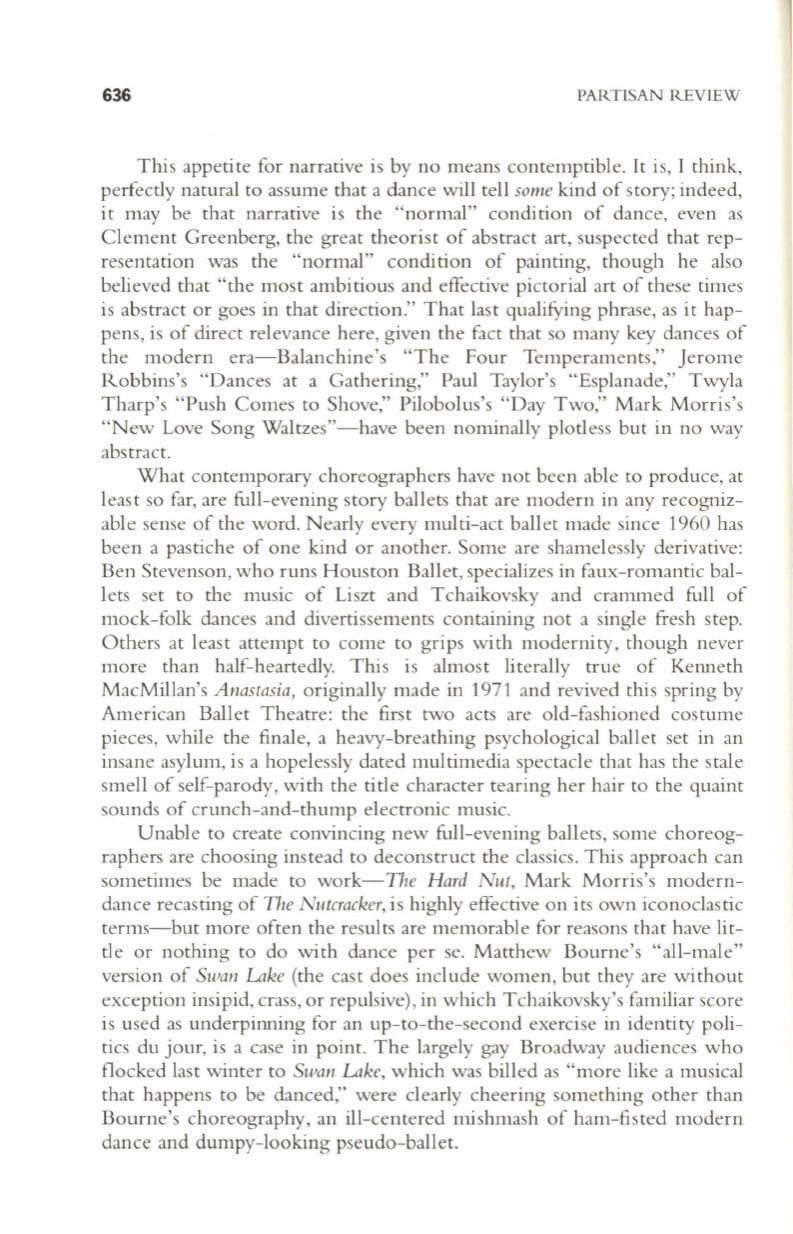
636
PARTISAN REVIEW
This appetite for narrative is by no means contemptible. It is, I think,
perfectly natural to assume that a dance will tell
some
kind of story; indeed,
it may be that narrative is the "normal" condition of dance, even as
Clement Greenberg, the great theorist of abstract art, suspected that rep–
resentation was the "normal" condition of painting, though he also
believed that "the most ambi tious and effective pictorial art of these times
is abstract or goes in that direction." That last qualifying phrase, as it hap–
pens, is of direct relevance here, given the fact that so many key dances of
the modern era-Balanchine's "The Four Temperaments," Jerome
Robbins's "Dances at a Gathering," Paul Taylor's "Esplanade," Twyla
Tharp's "Push Comes to Shove," Pilobolus's "Day Two," Mark Morris's
"New Love Song Waltzes"-have been nominally plotless but in no way
abstract.
What contemporary choreographers have not been able to produce, at
least so far, are full-evening story ballets that are modern in any recogniz–
able sense of the word. Nearly every multi-act ballet made since 1960 has
been a pastiche of one kind or another. Some are shamelessly derivative:
Ben Stevenson, who runs Houston Ballet, specializes in faux-romantic bal–
lets set to the music of Liszt and Tchaikovsky and crammed full of
mock-folk dances and divertissements containing not a single fresh step.
Others at least attempt to come to grips with modernity, though never
more than half-heartedly. This is almost literally true of Kenneth
MacMillan's
Anastasia,
originally made in 1971 and revived this spring by
American Ballet Theatre: the first two acts are old-fashioned costume
pieces, while the finale, a heavy-breathing psychological ballet set in an
insane asylum, is a hopelessly dated multimeclia spectacle that has the stale
smell of self-parody, with the title character tearing her hair to the quaint
sounds of crunch-and-thump electronic music.
Unable to create convincing new full-evening ballets, some choreog–
raphers are choosing instead to deconstruct the classics. This approach can
sometimes be made to
work-The Hard Nut,
Mark Morris's modern–
dance recasting of
The Nutcracker,
is highly effective on its own iconoclastic
terms-but more often the results are memorable for reasons that have lit–
tle or nothing to do with dance per se. Matthew Bourne's "all-male"
version of
Swan Lake
(the cast does include women, but they are without
exception insipid, crass, or repulsive), in which Tchaikovsky's familiar score
is used as underpinning for an up-to-the-second exercise in identity poli–
tics du jour, is a case in point. The largely gay Broadway aucliences who
flocked last winter to
Swan Lake,
which was billed as "more like a musical
that happens to be danced," were clearly cheering something other than
Bourne's choreography, an ill-centered mishmash of ham-fisted modern
dance and dumpy-looking pseudo-ballet.


